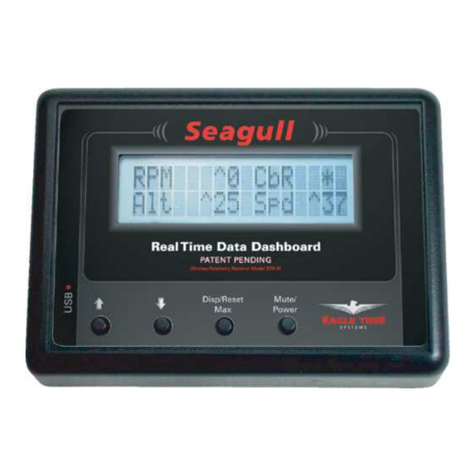
Copyright © 2008 Eagle Tree Systems, LLC
http://www.eagletreesystems.com
Config ring Metric vs English Units in Standalone Mode
When powered on, the LED readout will briefly display “0” if the unit is configured for English (Feet), or will display a “1” if configured for
metric (Meters). The factory default configuration is Feet.
To switch between English and metric units, connect the Standalone Cable
as described above, but don’t power the Altimeter. Then, connect a small
piece of wire between the unconnected pins of the Standalone Cable’s 4 pin
connector, corresponding to the brown and yellow dots on the label, as
shown in Figure 3. This creates a jumper between the brown and yellow
labeled pins.
Then, power the Altimeter via the Standalone Cable. A “0” will then flash
a few times to indicate that English units are configured, or a “1” will flash
if Metric units are configured. f the wrong units are configured, just
disconnect the power from the Altimeter and reconnect it.
Once the desired units are configured, disconnect from power and remove the wire jumper. Then, when reconnected to power, the desired
units should be displayed briefly (“0” or “1”).
Reading Altit de in Standalone Mode
When the Altimeter is powered on, after the Units setting is displayed (“0” or “1”), the highest altitude attained during your last flight is
repeatedly displayed, one digit at a time, on the LED. For example, if the highest altitude attained was 320 Feet, “3 – 2 – 0” will flash
repeatedly on the LED, with a pause (blank LED) after the altitude is completely displayed, but before it is displayed again.
After landing from your next flight, the highest altitude attained during that flight is displayed automatically, overwriting the highest altitude
from your prior flight. Note that the Altimeter must be powered off and on, and an altitude of at least 60 Feet (18 Meters) must be attained,
before a new highest altitude is displayed.
The highest altitude of your last flight is automatically saved, so that when you turn the unit back on, that altitude is displayed.
For example, if you fly and reach a max altitude of 100 Feet, when you land “1 – 0 – 0” will be displayed. Then, when you turn power off
and on, “1 – 0 – 0” will again be displayed. f you then fly again and reach an altitude of 500 Feet, “5 – 0 - 0” will be displayed when you
land.
Using the Altimeter with your eLogger
Windows Application and Firmware Update
To use the Altimeter, you must update to Eagle Tree Windows Application version 6.77 or higher. To update, download the latest
application from the support page of our website, located at http://eagletreesystems.com/Support/apps.htm . After downloading and
installing the Application, the firmware of your MicroPower eLogger will need to be updated. To upgrade your firmware, just choose
“Tools, Firmware Control” and click the Update button.
Connecting the Altimeter to the eLogger V3
The Altimeter plugs into the “LCD/TX” port of your eLogger V3, as shown in Figure 4. f you have a PowerPanel or other MicroSensors,
those can “daisy chain” connect to the pins on the side of your Altimeter, with the polarity as indicated on the Altimeter label. NOTE: The
Standalone Cable m st not be sed when connected to the eLogger!






















